Abstract
To improve health and fitness effectively through physical activity or exercise, we need to understand how this comes about. For many of these changes, the stimulus has been grossly defined in terms of type, intensity, duration, and frequency of exercise, but for others a dose-response relationship has not been determined. Physical activity that appears to provide the most diverse health benefits consists of dynamic, rhythmical contractions of large muscles that transport the body over distance or against gravity at a moderate intensity relative to capacity for extended periods of time during which 200 to 400 kilocalories (or 4 kilocalories per kilogram of body weight) are expended. For optimal health benefits, such activity should be performed daily or at least every other day and should be supplemented with some heavy resistance and flexibility exercises. The greatest benefits are achieved when the least active individuals become moderately active; much less benefit is apparent when the already active individual becomes extremely active. Overexertion or inappropriate exercise can produce significant health risks. Research is needed to characterize better the health-promoting features of physical activity and exercise.
Full text
PDF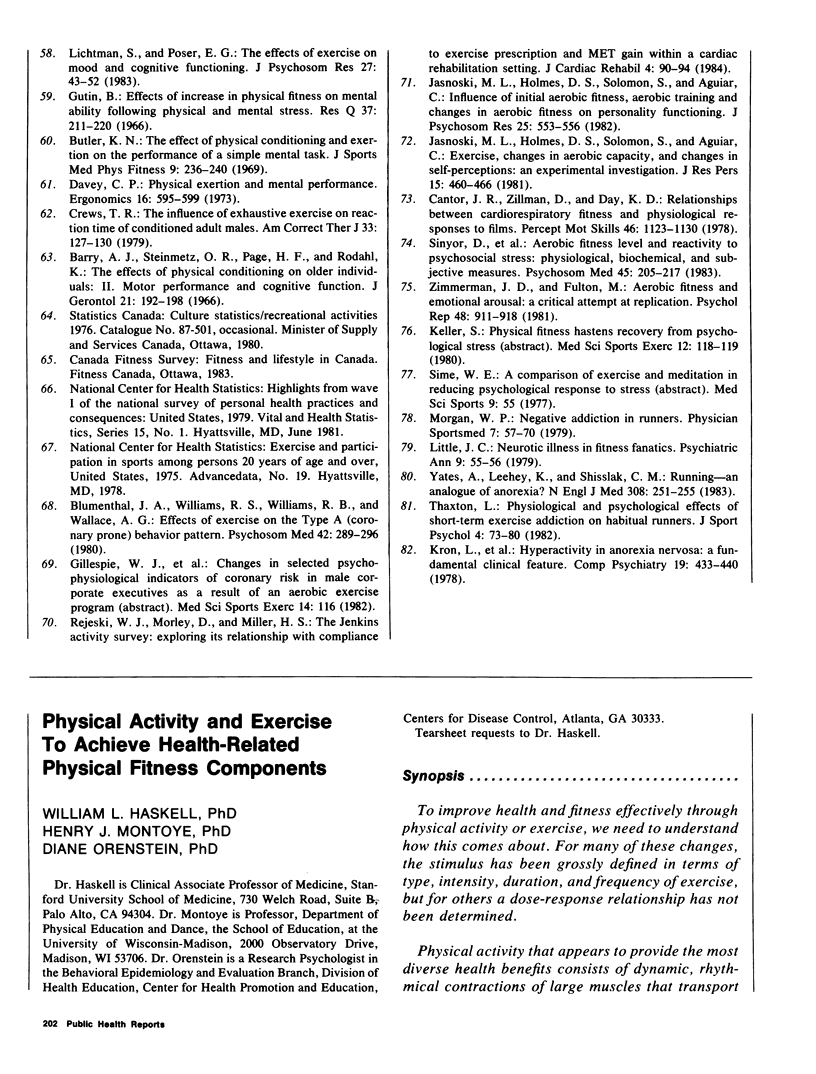
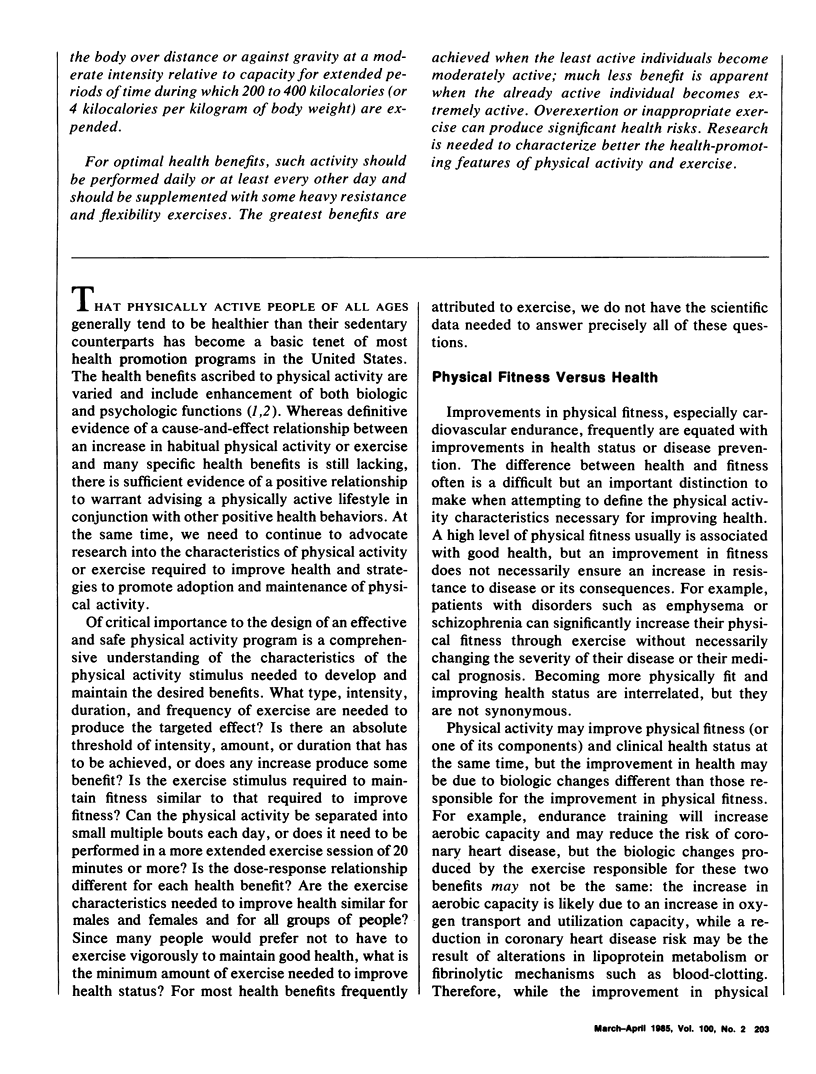


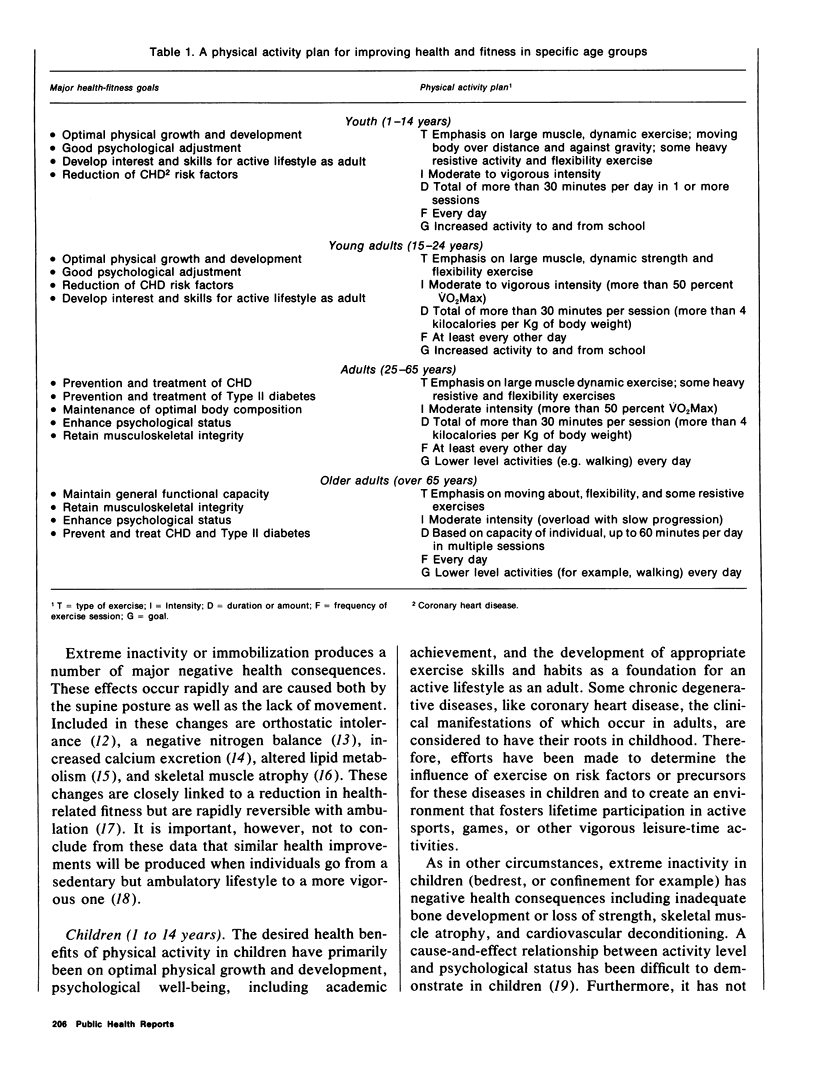
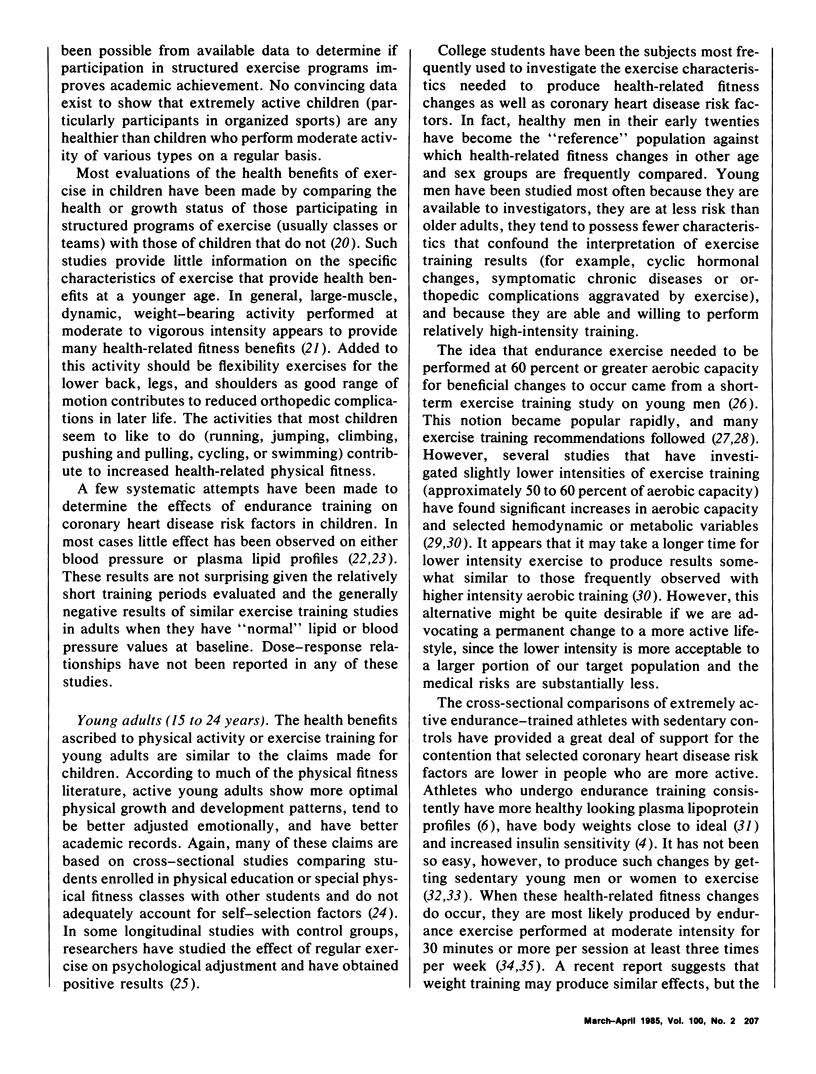

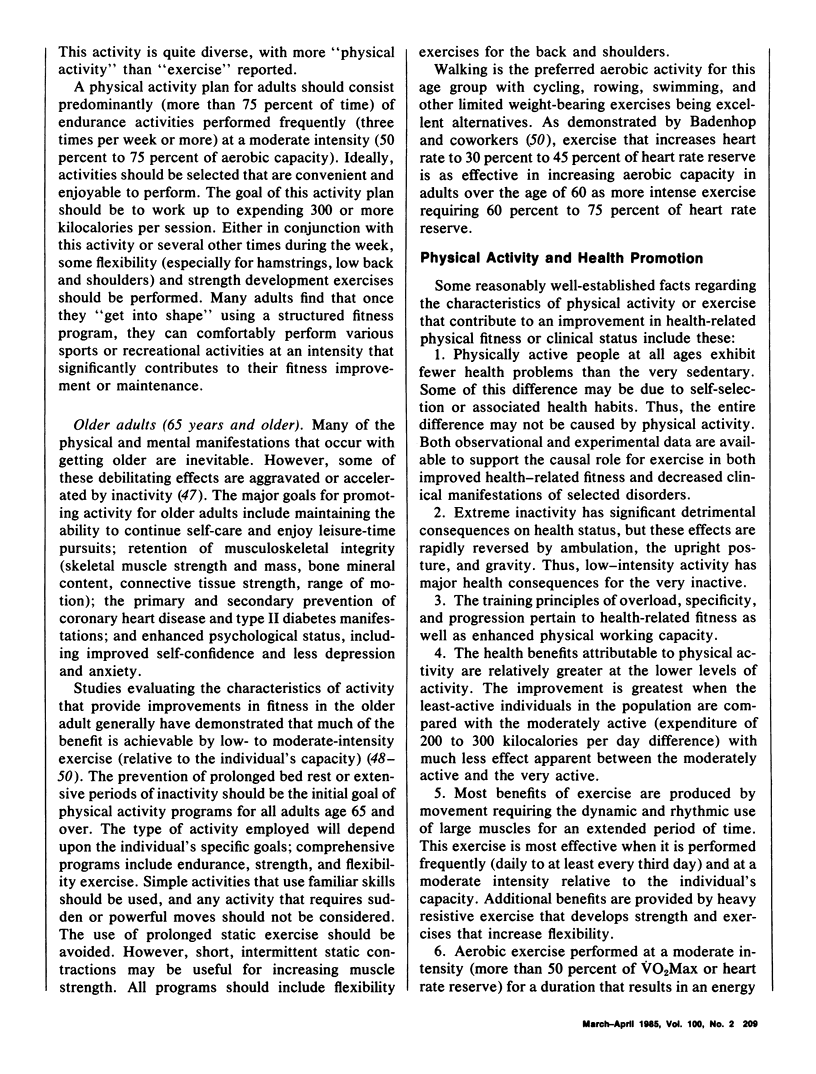
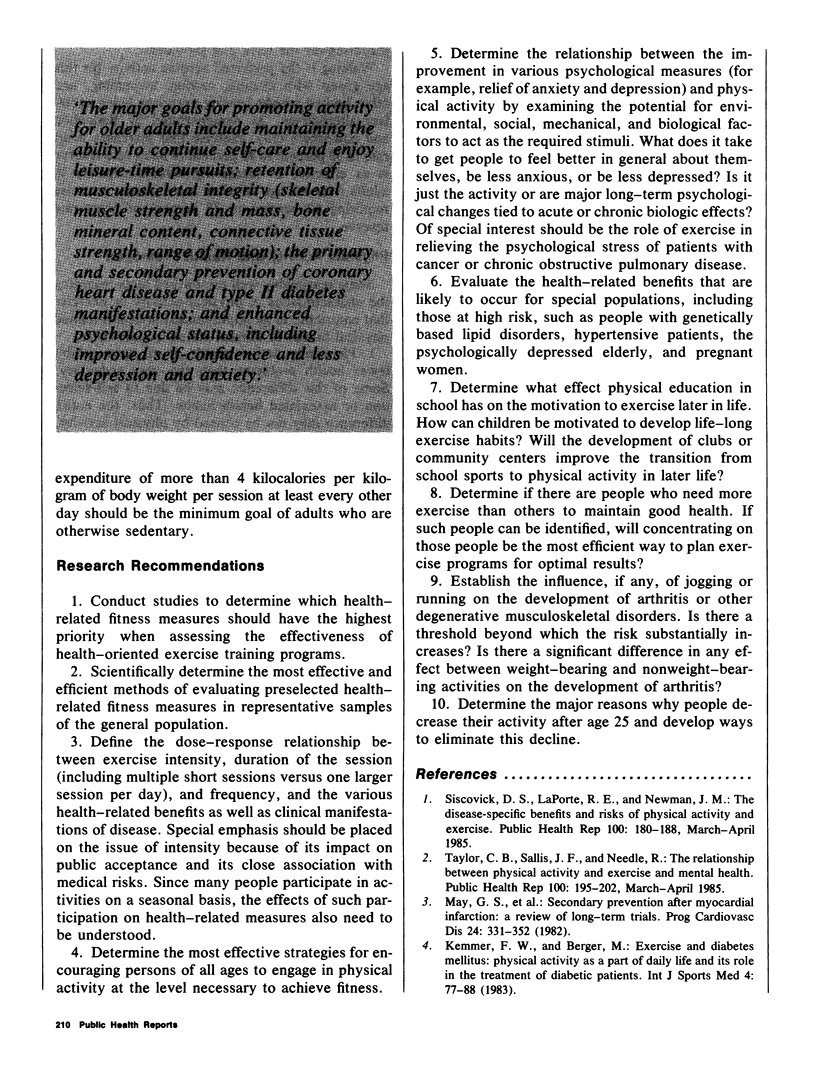
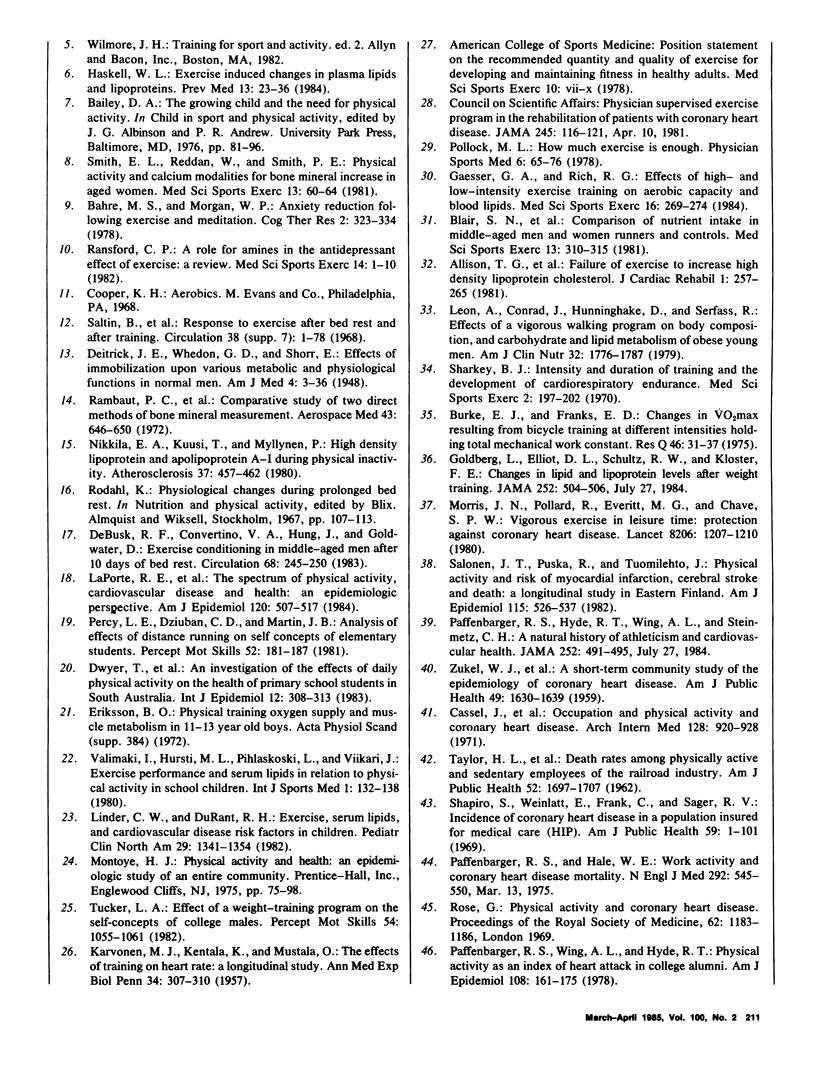
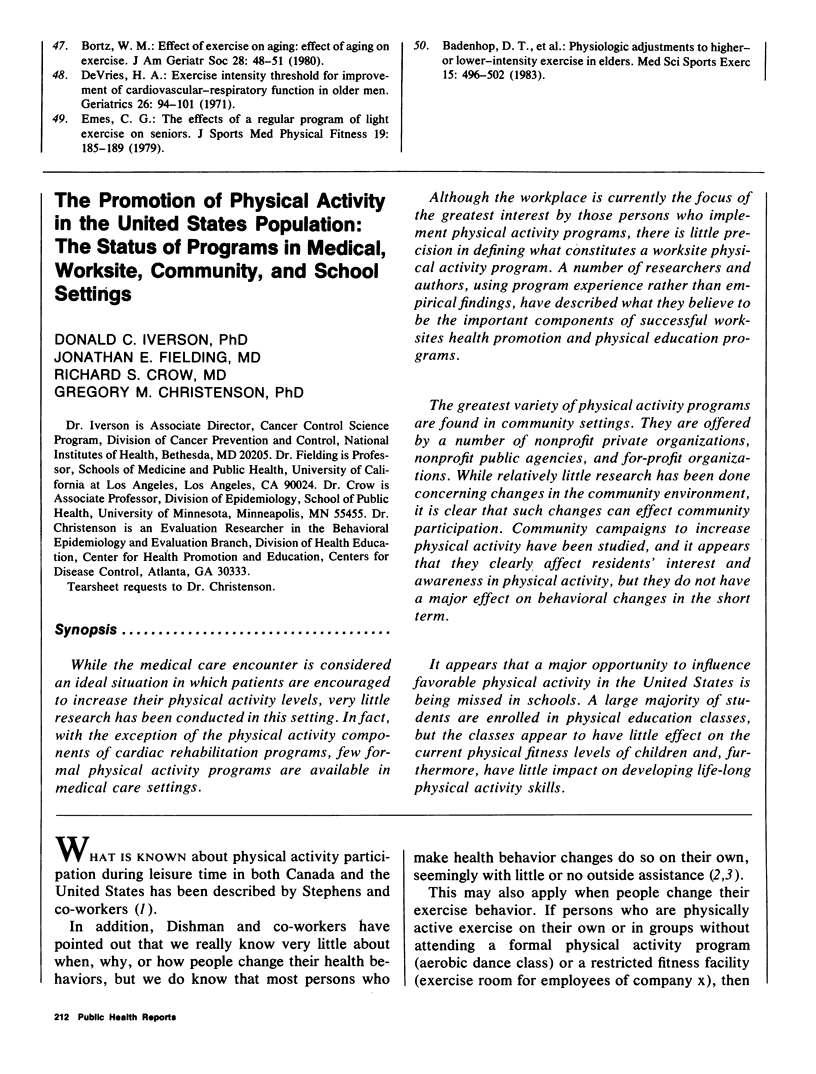
Selected References
These references are in PubMed. This may not be the complete list of references from this article.
- Badenhop D. T., Cleary P. A., Schaal S. F., Fox E. L., Bartels R. L. Physiological adjustments to higher- or lower-intensity exercise in elders. Med Sci Sports Exerc. 1983;15(6):496–502. [PubMed] [Google Scholar]
- Blair S. N., Ellsworth N. M., Haskell W. L., Stern M. P., Farquhar J. W., Wood P. D. Comparison of nutrient intake in middle-aged men and women runners and controls. Med Sci Sports Exerc. 1981;13(5):310–315. [PubMed] [Google Scholar]
- Bortz W. M., 2nd Effect of exercise on aging--effect of aging on exercise. J Am Geriatr Soc. 1980 Feb;28(2):49–51. doi: 10.1111/j.1532-5415.1980.tb00204.x. [DOI] [PubMed] [Google Scholar]
- Burke E. J., Franks B. D. Changes in V02max resulting from bicycle training at different intensities holding total mechanical work constant. Res Q. 1975 Mar;46(1):31–37. [PubMed] [Google Scholar]
- Cassel J., Heyden S., Bartel A. G., Kaplan B. H., Tyroler H. A., Cornoni J. C., Hames C. G. Occupation and physical activity and coronary heart disease. Arch Intern Med. 1971 Dec;128(6):920–928. [PubMed] [Google Scholar]
- DeBusk R. F., Convertino V. A., Hung J., Goldwater D. Exercise conditioning in middle-aged men after 10 days of bed rest. Circulation. 1983 Aug;68(2):245–250. doi: 10.1161/01.cir.68.2.245. [DOI] [PubMed] [Google Scholar]
- Dwyer T., Coonan W. E., Leitch D. R., Hetzel B. S., Baghurst R. A. An investigation of the effects of daily physical activity on the health of primary school students in South Australia. Int J Epidemiol. 1983 Sep;12(3):308–313. doi: 10.1093/ije/12.3.308. [DOI] [PubMed] [Google Scholar]
- Emes C. G. The effects of a regular program of light exercise on seniors. J Sports Med Phys Fitness. 1979 Jun;19(2):185–190. [PubMed] [Google Scholar]
- Fisher E. P., Fisher R. L. Parents of disturbed enuretic and non-enuretic children. Percept Mot Skills. 1981 Feb;52(1):181–182. doi: 10.2466/pms.1981.52.1.181. [DOI] [PubMed] [Google Scholar]
- Gaesser G. A., Rich R. G. Effects of high- and low-intensity exercise training on aerobic capacity and blood lipids. Med Sci Sports Exerc. 1984 Jun;16(3):269–274. [PubMed] [Google Scholar]
- Goldberg L., Elliot D. L., Schutz R. W., Kloster F. E. Changes in lipid and lipoprotein levels after weight training. JAMA. 1984 Jul 27;252(4):504–506. [PubMed] [Google Scholar]
- Haskell W. L. Exercise-induced changes in plasma lipids and lipoproteins. Prev Med. 1984 Jan;13(1):23–36. doi: 10.1016/0091-7435(84)90038-0. [DOI] [PubMed] [Google Scholar]
- KARVONEN M. J., KENTALA E., MUSTALA O. The effects of training on heart rate; a longitudinal study. Ann Med Exp Biol Fenn. 1957;35(3):307–315. [PubMed] [Google Scholar]
- Kemmer F. W., Berger M. Exercise and diabetes mellitus: physical activity as a part of daily life and its role in the treatment of diabetic patients. Int J Sports Med. 1983 May;4(2):77–88. doi: 10.1055/s-2008-1026017. [DOI] [PubMed] [Google Scholar]
- LaPorte R. E., Adams L. L., Savage D. D., Brenes G., Dearwater S., Cook T. The spectrum of physical activity, cardiovascular disease and health: an epidemiologic perspective. Am J Epidemiol. 1984 Oct;120(4):507–517. doi: 10.1093/oxfordjournals.aje.a113911. [DOI] [PubMed] [Google Scholar]
- Leon A. S., Conrad J., Hunninghake D. B., Serfass R. Effects of a vigorous walking program on body composition, and carbohydrate and lipid metabolism of obese young men. Am J Clin Nutr. 1979 Sep;32(9):1776–1787. doi: 10.1093/ajcn/32.9.1776. [DOI] [PubMed] [Google Scholar]
- Linder C. W., DuRant R. H. Exercise, serum lipids, and cardiovascular disease--risk factors in children. Pediatr Clin North Am. 1982 Dec;29(6):1341–1354. doi: 10.1016/s0031-3955(16)34284-5. [DOI] [PubMed] [Google Scholar]
- May G. S., Eberlein K. A., Furberg C. D., Passamani E. R., DeMets D. L. Secondary prevention after myocardial infarction: a review of long-term trials. Prog Cardiovasc Dis. 1982 Jan-Feb;24(4):331–352. doi: 10.1016/0033-0620(82)90010-x. [DOI] [PubMed] [Google Scholar]
- Morris J. N., Everitt M. G., Pollard R., Chave S. P., Semmence A. M. Vigorous exercise in leisure-time: protection against coronary heart disease. Lancet. 1980 Dec 6;2(8206):1207–1210. doi: 10.1016/s0140-6736(80)92476-9. [DOI] [PubMed] [Google Scholar]
- Nikkilä E. A., Kuusi T., Myllynen P. High density lipoprotein and apolipoprotein A-i during physical inactivity. Demonstration at low levels in patients with spine fracture. Atherosclerosis. 1980 Nov;37(3):457–462. doi: 10.1016/0021-9150(80)90151-3. [DOI] [PubMed] [Google Scholar]
- Paffenbarger R. S., Hale W. E. Work activity and coronary heart mortality. N Engl J Med. 1975 Mar 13;292(11):545–550. doi: 10.1056/NEJM197503132921101. [DOI] [PubMed] [Google Scholar]
- Paffenbarger R. S., Jr, Hyde R. T., Wing A. L., Steinmetz C. H. A natural history of athleticism and cardiovascular health. JAMA. 1984 Jul 27;252(4):491–495. [PubMed] [Google Scholar]
- Paffenbarger R. S., Jr, Wing A. L., Hyde R. T. Physical activity as an index of heart attack risk in college alumni. Am J Epidemiol. 1978 Sep;108(3):161–175. doi: 10.1093/oxfordjournals.aje.a112608. [DOI] [PubMed] [Google Scholar]
- Rambaut P. C., Dietlein L. F., Vogel J. M., Smith M. C., Jr Comparative study of two direct methods of bone mineral measurement. Aerosp Med. 1972 Jun;43(6):646–650. [PubMed] [Google Scholar]
- Ransford C. P. A role for amines in the antidepressant effect of exercise: a review. Med Sci Sports Exerc. 1982;14(1):1–10. doi: 10.1249/00005768-198201000-00001. [DOI] [PubMed] [Google Scholar]
- Rose G. Physical activity and coronary heart disease. Proc R Soc Med. 1969 Nov;62(11 Pt 2):1183–1188. [PMC free article] [PubMed] [Google Scholar]
- Salonen J. T., Puska P., Tuomilehto J. Physical activity and risk of myocardial infarction, cerebral stroke and death: a longitudinal study in Eastern Finland. Am J Epidemiol. 1982 Apr;115(4):526–537. doi: 10.1093/oxfordjournals.aje.a113334. [DOI] [PubMed] [Google Scholar]
- Sharkey B. J. Intensity and duration of training and the development of cardiorespiratory endurance. Med Sci Sports. 1970 Winter;2(4):197–202. [PubMed] [Google Scholar]
- Siscovick D. S., LaPorte R. E., Newman J. M. The disease-specific benefits and risks of physical activity and exercise. Public Health Rep. 1985 Mar-Apr;100(2):180–188. [PMC free article] [PubMed] [Google Scholar]
- Smith E. L., Jr, Reddan W., Smith P. E. Physical activity and calcium modalities for bone mineral increase in aged women. Med Sci Sports Exerc. 1981;13(1):60–64. [PubMed] [Google Scholar]
- Taylor C. B., Sallis J. F., Needle R. The relation of physical activity and exercise to mental health. Public Health Rep. 1985 Mar-Apr;100(2):195–202. [PMC free article] [PubMed] [Google Scholar]
- ZUKEL W. J., LEWIS R. H., ENTERLINE P. E., PAINTER R. C., RALSTON L. S., FAWCETT R. M., MEREDITH A. P., PETERSON B. A short-term community study of the epidemiology of coronary heart disease. A preliminary report on the North Dakota study. Am J Public Health Nations Health. 1959 Dec;49:1630–1639. doi: 10.2105/ajph.49.12.1630. [DOI] [PMC free article] [PubMed] [Google Scholar]


